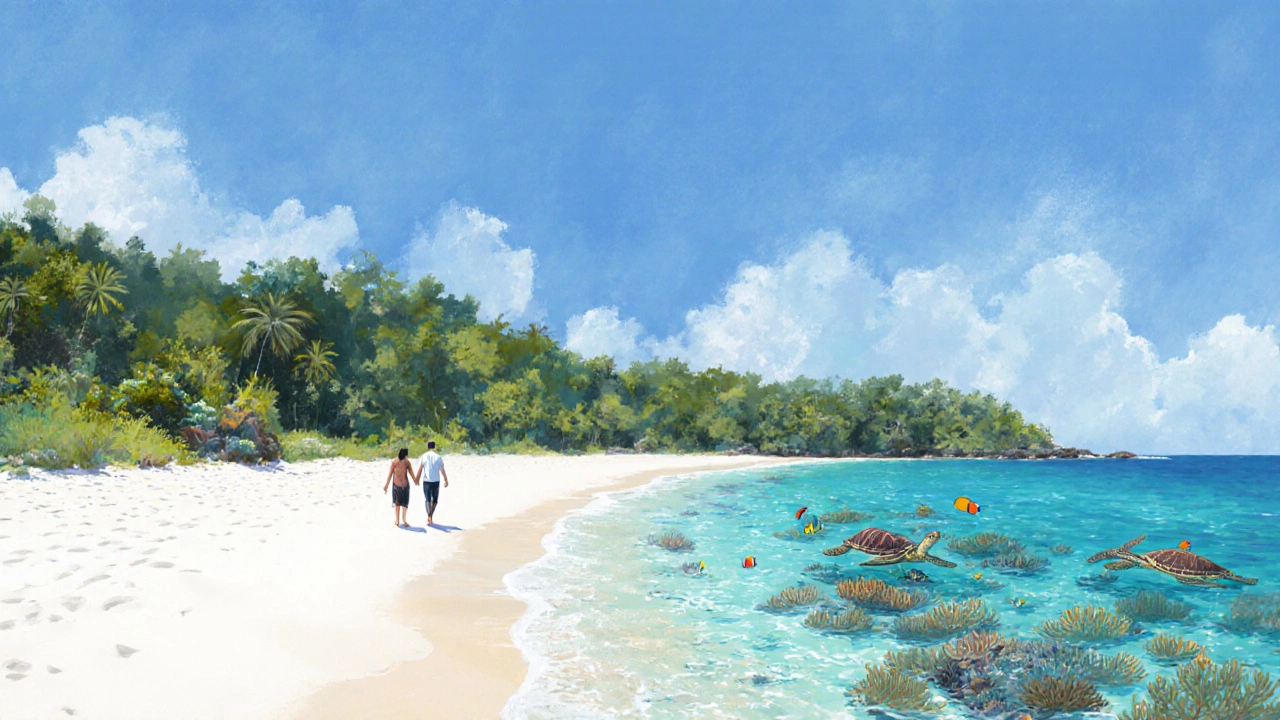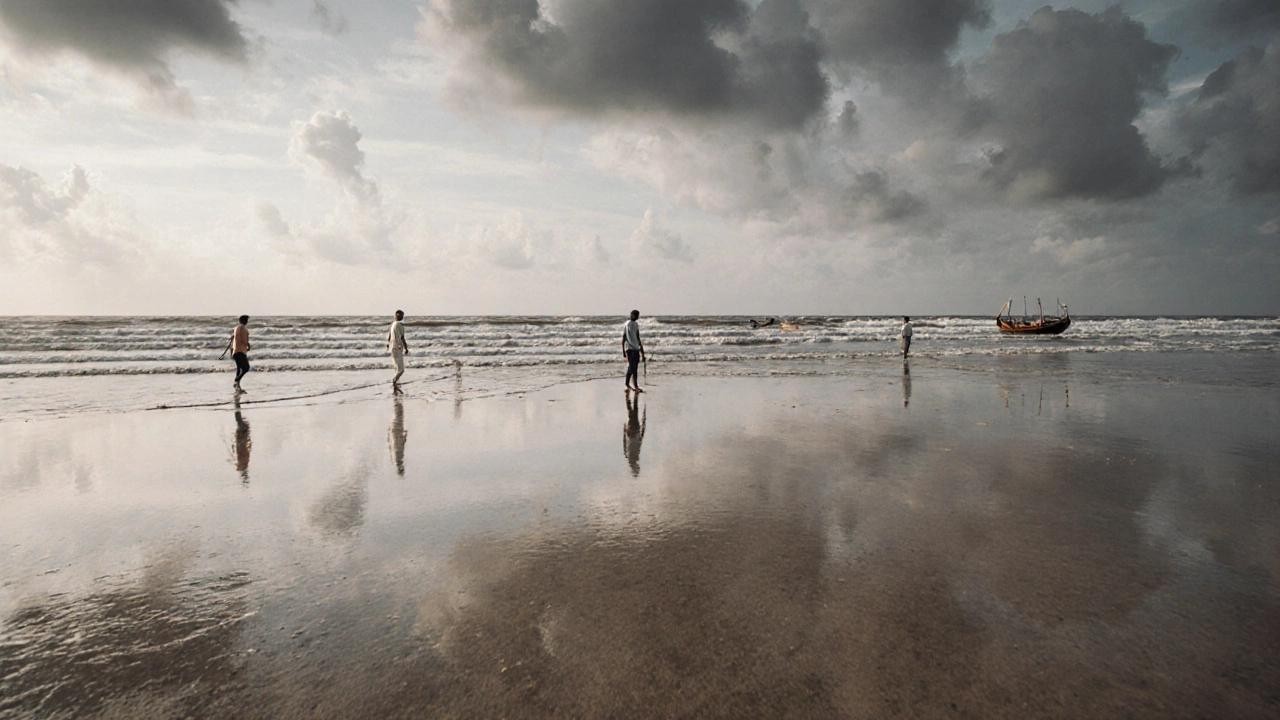When you think of India, you might picture bustling cities, ancient temples, or mountain treks. But one of the country’s best-kept secrets? Its long, sun-drenched coastlines. India has over 7,500 kilometers of shoreline, and if you’re looking for sand, surf, and sea breeze, you don’t need to fly overseas. The real question isn’t which Indian tourist destination is known for beaches - it’s which one suits your vibe.
Goa: The Original Beach Hub
Goa is India’s beach capital for a reason. It’s not just about the water - it’s the whole package. White sand, palm trees, shacks serving fresh coconut water, and music drifting from beach bars. North Goa is where the party lives: Baga, Calangute, and Anjuna draw crowds with their lively atmosphere, water sports, and night markets. South Goa is quieter. Palolem, Colva, and Agonda offer calm waters, yoga retreats, and long walks at sunset. The Portuguese influence shows in the architecture, the food (think vindaloo and bebinca), and even the churches dotting the hills.
Goa’s beaches aren’t just pretty. They’re functional. You can snorkel in the clear waters off Grande Island, take a dolphin-watching boat trip from Mobor, or rent a kayak and paddle through the mangroves near Cotigao. Over 8 million tourists visit Goa every year - and most of them come for the beach.
Andaman and Nicobar Islands: Untouched Paradise
If Goa feels too crowded, head south to the Andaman Islands. These 572 islands in the Bay of Bengal are like stepping into a postcard. Radhanagar Beach on Havelock Island is consistently ranked among Asia’s best. The sand is so fine it feels like powdered sugar underfoot. The water? Crystal clear, with coral reefs just a few meters offshore. Snorkeling here isn’t a tour - it’s an everyday experience. You’ll see parrotfish, sea turtles, and sometimes even reef sharks.
Don’t miss the beaches of Elephant Beach or Neil Island. Both are quieter, perfect for couples or solo travelers wanting peace. The water temperature stays warm year-round, and the lack of big resorts means you won’t find high-rises blocking the view. The only downside? Getting there. Flights are limited and pricey, but once you’re on the island, time slows down.
Kerala: Backwaters and Beaches Combined
Kerala’s coastline doesn’t just offer beaches - it offers a whole rhythm of life. Kovalam, near Trivandrum, is the most famous. Lighthouse Beach, Hawah Beach, and Samudra Beach form a crescent of sand backed by coconut groves. It’s less about nightlife and more about Ayurvedic massages, sunset yoga, and slow mornings with chai.
Just north of Kovalam, you’ll find Varkala. Its cliffs rise 40 meters above the sea, giving you a view most beaches can’t match. The beach here is rocky in places, but the water is clean, and the cliffs are dotted with cafes and meditation centers. Unlike Goa, Varkala doesn’t feel like a tourist trap. Locals still fish from wooden boats, and the air smells of salt and jasmine.
And if you’re up for something different, combine your beach time with a houseboat ride through the backwaters. It’s not just a side trip - it’s part of the Kerala experience.
Odisha: Hidden Gems on the East Coast
Most travelers skip Odisha, but that’s their loss. Puri Beach is one of the oldest beach destinations in India, dating back to the 12th century. It’s not just about swimming - it’s about culture. The Jagannath Temple sits right behind the shore, and every evening, locals gather to light oil lamps along the sand. The beach here is wide, less crowded than Goa, and perfect for long walks.
Just 40 kilometers north is Chandipur. This beach is wild. At low tide, the water recedes up to 5 kilometers - you can walk out to where the sea used to be. It’s one of the few places in the world where you can literally walk on the ocean floor. The tide comes back fast, so timing matters. Locals know the rhythm. Tourists? They’re usually caught off guard.
Another spot worth mentioning is Gopalpur-on-Sea. It’s quiet, clean, and has a colonial-era lighthouse. No big resorts. No loud music. Just families fishing and kids flying kites. If you want a beach that feels untouched, this is it.

Maharashtra: Beyond Mumbai’s Shoreline
Mumbai has a beach - Juhu - but it’s noisy, crowded, and not the best for swimming. The real gems are further down the coast. Alibaug, just 100 kilometers south, is a weekend escape for Mumbai residents. Kihim Beach and Nagaon Beach offer clean sand, calm waters, and affordable stays. You’ll find beach shacks serving fresh prawns and grilled corn, not overpriced cocktails.
Then there’s Ganpatipule. A small town with one main beach, surrounded by hills and temples. The water here is pure, the crowds are thin, and the temple of Lord Ganesha sits right at the shore. It’s spiritual, serene, and rarely on tourist radars. If you want to disconnect - really disconnect - this is your spot.
What Makes a Great Beach in India?
Not all Indian beaches are the same. Some are for parties. Others are for silence. Here’s what to look for:
- Water clarity: Andaman and Kerala win here. Goa’s water is decent in the off-season (November-February).
- Safety: Avoid beaches without lifeguards or strong undertows. Places like Palolem and Kovalam are safer for swimming.
- Accessibility: Goa and Kovalam have good roads and flights. Andaman requires planning.
- Amenities: Goa and Kovalam have hotels, restaurants, and ATMs. Remote beaches like Chandipur or Ganpatipule? Bring cash, water, and snacks.
Also, avoid the monsoon season (June-September). Rain turns beaches muddy, waves get dangerous, and many places shut down.
When to Go
The best time for Indian beaches is between October and March. The weather is dry, the humidity drops, and the sea is calm. November to February is peak season - book ahead if you’re going to Goa or Andaman. April and May are hot but quiet. July to September? Skip it unless you’re into monsoon photography.

Final Thought: It’s Not Just About the Sand
India’s beaches aren’t just places to sunbathe. They’re cultural spaces. In Goa, you’ll hear Konkani folk songs. In Kerala, you’ll smell turmeric and coconut oil from nearby Ayurvedic centers. In Odisha, you’ll see fishermen mending nets the same way their grandfathers did. In Andaman, you’ll hear the echo of colonial history in the old British bungalows.
Choose your beach based on what you’re looking for. Party? Goa. Silence? Andaman. Culture? Kerala. Adventure? Chandipur. Peace? Ganpatipule. There’s no single answer to which destination is known for beaches - because India has them all.
Which Indian beach is the cleanest?
Radhanagar Beach in the Andaman Islands is widely considered the cleanest. It has no plastic litter, no high-rise hotels, and local authorities enforce strict waste rules. Kovalam in Kerala and Gopalpur-on-Sea in Odisha also maintain high cleanliness standards thanks to community-led efforts.
Are Indian beaches safe for swimming?
Many are, but not all. Beaches like Palolem, Kovalam, and Alibaug have calm waters and lifeguards during peak season. Avoid beaches with strong undertows like parts of Goa’s Calangute or Mumbai’s Juhu. Always check local warnings and never swim alone at dusk.
Can I visit Indian beaches in monsoon season?
It’s possible, but not recommended for swimming or sunbathing. Heavy rains make beaches muddy, waves dangerous, and many shacks close. However, photographers and nature lovers visit during monsoon for dramatic skies, waterfalls near beaches, and fewer crowds. Andaman’s beaches are less affected than the mainland.
Which beach is best for couples?
Palolem Beach in Goa and Varkala Beach in Kerala are top picks. Both offer quiet stretches of sand, sunset views, and cozy shacks with private seating. Andaman’s Radhanagar Beach is also ideal - remote, romantic, and perfect for long walks without interruptions.
Do I need a permit to visit Indian beaches?
Most beaches in mainland India don’t require permits. But the Andaman and Nicobar Islands do. Foreign tourists need a Restricted Area Permit (RAP), which is easy to get on arrival at Port Blair. Indian citizens don’t need one. Always check current rules before flying.
What to Pack for an Indian Beach Trip
- UV-blocking rash guard (sun is strong even on cloudy days)
- Waterproof phone case (saltwater + sand = quick damage)
- Reusable water bottle (plastic bags are banned in many coastal areas)
- Flip-flops (sand gets hot, and cobblestones are rough)
- Light cotton clothes (breathable fabrics beat synthetic ones)
- Small first-aid kit (for minor cuts from coral or rocks)
Don’t forget sunscreen - mineral-based, reef-safe options work best. Many beaches now ban chemical sunscreens to protect marine life. Look for labels that say ‘non-nano zinc oxide’.
Next Steps
If you’re planning a trip, start with your vibe. Want nightlife? Go to Goa. Want isolation? Head to Andaman. Want culture with your sunburn? Kerala’s your pick. Book flights early - especially to the Andamans. And remember: the best beaches aren’t the most Instagrammed ones. They’re the ones where you forget to check your phone.
